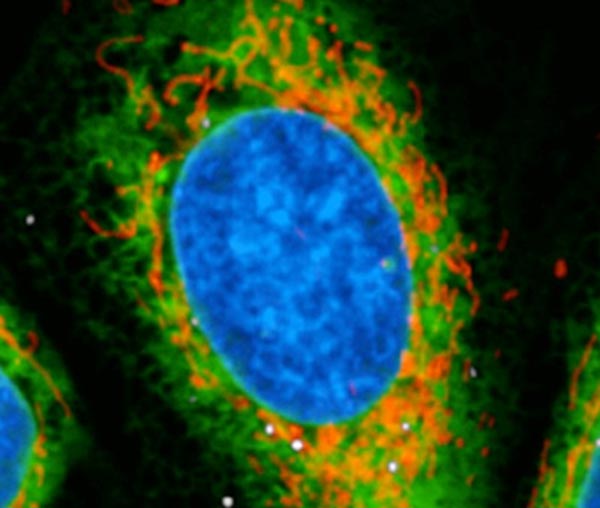Legionellosis: a novel mechanism …

Human monocyte derived macrophages incubated with Legionella pneumophila derived extracellular vesicles (white), endoplasmic reticulum (green); nucleus (blue), mitochondria (orange).
Credit: © Institut Pasteur
… by which the bacterium Legionella pneumophila regulates the immune response of its host cells.
Legionellosis or Legionnaires’ disease affected more than 1 800 people in France in 2019 and caused 160 deaths. This emerging disease is caused by Legionella pneumophila, an environmental bacterium that thrives in hot water systems. Researchers from the Institut Pasteur, the CNRS, the University of Paris have discovered a mechanism that allows Legionella pneumophila to target the immune response of the cells it infects by secreting a small regulatory RNA.
This mechanism, not described before, facilitates the survival and proliferation of Legionella pneumophila during infection. The work provides precious information on the strategies used by bacteria to manipulate their host cells. This research has been published online on February 9 on the Nature Communications website.
Intracellular pathogens adopt various strategies to circumvent immune defenses and proliferate inside the cells they infect. Legionella pneumophila has a large repository of effector proteins[1] that mimic host cell functions and are used by the pathogen to manipulate host signaling pathways to the pathogens advantage[2].
The teams of Carmen Buchrieser, head of the unit Biology of the Intracellular Bacteria at the Institut Pasteur and associated to CNRS, in collaboration with Gregory Lavieu at the Université de Paris and associated to Inserm and CNRS, have discovered that Legionella pneumophila secretes extracellular vesicles into the host cell during infection in which it packs small, regulatory RNA molecules. These regulatory RNAs mimic eukaryotic regulatory RNAs called micro RNAs that already exist naturally in the host cell.
The researchers have discovered that these two bacterial RNAs, named RsmY and tRNA-Phe, function in the host cell in a microRNA-like manner. They downregulate RIG-I, a protein in the cell that detects foreign RNA molecules in order to initiate an immune response. The down regulation of the expression of RIG-I leads to a diminished host immune response and a better replication of Legionella pneumophila.
This work sheds new light on the diverse, sophisticated strategies employed by intracellular pathogens for survival and development during infection.
[1] Proteins secreted in the host cell via a dedicated secretion system called type IV secretion system
[2] Cazalet et al. Nature genetics 2004 ; Gomez Valero et al., PNAS 2019
Journal: Nature Communications DOI: 10.1038/s41467-022-28454-x Article Title: Translocated Legionella pneumophila small RNAs mimic eukaryotic microRNAs targeting the host immune response Article Publication Date: 9-Feb-2022
Media Contact
Rebeyrotte Myriam
Institut Pasteur
myriam.rebeyrotte@pasteur.fr
Office: 0033-145-688-101
All latest news from the category: Life Sciences and Chemistry
Articles and reports from the Life Sciences and chemistry area deal with applied and basic research into modern biology, chemistry and human medicine.
Valuable information can be found on a range of life sciences fields including bacteriology, biochemistry, bionics, bioinformatics, biophysics, biotechnology, genetics, geobotany, human biology, marine biology, microbiology, molecular biology, cellular biology, zoology, bioinorganic chemistry, microchemistry and environmental chemistry.
Newest articles

Trotting robots reveal emergence of animal gait transitions
A four-legged robot trained with machine learning by EPFL researchers has learned to avoid falls by spontaneously switching between walking, trotting, and pronking – a milestone for roboticists as well…

Innovation promises to prevent power pole-top fires
Engineers in Australia have found a new way to make power-pole insulators resistant to fire and electrical sparking, promising to prevent dangerous pole-top fires and reduce blackouts. Pole-top fires pose…

Possible alternative to antibiotics produced by bacteria
Antibacterial substance from staphylococci discovered with new mechanism of action against natural competitors. Many bacteria produce substances to gain an advantage over competitors in their highly competitive natural environment. Researchers…





















